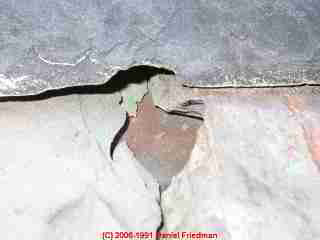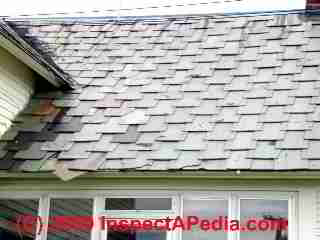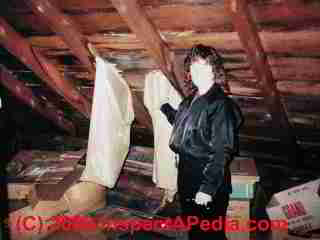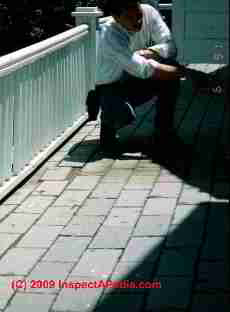 Slate Roof Repair History
Slate Roof Repair History
- POST a QUESTION or COMMENT about assessing a slate roof condition by observing its repair history
Slate roof repair history:
The repair history of a slate roof can help you assess the remaining roof life, roof condition, probable roof leak points, and the expected cost of maintaining a slate roof.
Here we include photos and text that help a roof inspector or building owner spot where repairs have been made to a slate roof, why the repairs were made, what was probably wrong, and what, thus, is the overall condition of the roof.
InspectAPedia tolerates no conflicts of interest. We have no relationship with advertisers, products, or services discussed at this website.
- Daniel Friedman, Publisher/Editor/Author - See WHO ARE WE?
Slate Roof Repair history helps diagnose the condition of a slate roof
 Tar or roofing mastic is normally an indication of improper maintenance. It should be
considered a temporary, unreliable repair. Tar or roofing cement should
not be found at chimneys, sidewall flashings, plumbing vents, or elsewhere.
Tar or roofing mastic is normally an indication of improper maintenance. It should be
considered a temporary, unreliable repair. Tar or roofing cement should
not be found at chimneys, sidewall flashings, plumbing vents, or elsewhere.
Our photo at left shows tar patching in the dormer valley and below the dormer. But further loose slates are falling off of this roof, possibly damaged during application of the valley tar.
The tar itself usually remains effective as a sealant only for a year or so. While in place, tar traps moisture within the slates, causing the slate itself to deteriorate. When flashings leak on a roof they should be repaired or replaced as necessary, without using roof cement.
Copper tabs and fastener failures on slate roofs:
Watch for numerous copper tabs at the center of replacement shingles. These indicate that repairs have been made and they may be a clue about the overall condition of the fasteners. In a first-class slate repair you should not be able to see the copper tabs. The Old-House Journal April 1984 roofing issue describes an alternative method for securing slates which will leave a copper tab exposed.
Expert roofers have a less visible method of fastening the replacement slate. [See "Repairing Slates" sidebar article.]
Our page top photo shows a perfectly good repair made by sliding a piece of copper flashing up under slates to cover a hole that may have been made by a nail pop from below.
Asphalt shingles applied over slate roofs:
Using asphalt over slates is surprisingly common "re-roof" procedure as it avoids labor and disposal costs for the slate material. [In some areas of the Northeast it also represents the popularity of lower-cost asphalt and the dearth of experienced slaters who might have repaired the slate roof.]
When nailing the asphalt shingles it is common to find only a poor bond of new nails to original roof decking.
The slates below tend to chip and bulge the new material resulting in a "peanut brittle" or "popcorn" effect. S
ince the comparatively large thermal mass of the slates retains heat, the asphalt shingles are "cooked" from their backside as well as from their front when exposed to sunlight. The life of such shingles is estimated by some to be half the normal span.
Leaks in Slate Roofs
 All slate roofs probably have at least some flashing, slate, or other
damage or mechanical installation errors. Some conditions such as
a side lap error, damaged slate, or even flashing error may leak only
in certain weather conditions such as windy rain storms from a particular
direction, water backup behind ice dams, or prolonged rains.
All slate roofs probably have at least some flashing, slate, or other
damage or mechanical installation errors. Some conditions such as
a side lap error, damaged slate, or even flashing error may leak only
in certain weather conditions such as windy rain storms from a particular
direction, water backup behind ice dams, or prolonged rains.
Where slates are missing near valleys the adjoining slates may be damaged as well.
Openings may cause leaks or water to pass below the valley flashing even if the flashing looks intact. Where there were previous repairs it's common for the felt underlayment to be torn as well. If there are porous slates or openings above the tears in the felt, water may leak through.
Ice dams
at roof eaves can be a serious leak source on slate as most other roof systems. Traditionally 30# felt was used at eaves as "insurance" against this problem. Some slate suppliers recommend this heavier felt for all underlayment, not just at the eaves.
However two components conspire to reduce the effectiveness of felt as ice-dam protection: every nail at the eaves punctures the felt, and with age felts often dry and disintegrate before the slates have worn out.
Ice dam protection is improved in new or re-roof applications using the newer sticky membranes such as WR Grace's Ice and Water ShieldTM.
However the preferred solution to this problem is proper attic ventilation. Good venting avoids the ice-dam problem and adds reductions in winter moisture and summer heat problems. Old houses whose attics have been converted to living space, particularly with un-vented ceilings following the underside of fully-insulated roofs are likely to be serious moisture and heat traps.
Slope requirements for slate roofs
In conventional roofing design slates are used on roofs with a slope of at least 4" of rise in 12" of run, that is, on 4 in 12 roofs.
A 3" head lap is used, often 4" when the slope is less than 8 in 12. So a 20" long slate, with a 3" head lap, would have an exposure of 8.5".
 For 18" slates the exposure is 7.5", and for 16" slates, 6.5".
Roofs with less head lap or more exposure may be more leak-prone.
For 18" slates the exposure is 7.5", and for 16" slates, 6.5".
Roofs with less head lap or more exposure may be more leak-prone.
But slates have been used even on dead flat surfaces such as balconies and decks, as we show here.
When we inspected this slate covered deck in Newburgh, NY in 1991 we found that the slates had been set in a bed of tar over canvas to form a flat roof that lasted without leaking for nearly 50 years.
But as you can see in our photo, the slates had now come loose from their bed of tar.
This series of detailed slate roof inspection and repair articles describes procedures for evaluating the condition of slate roofing. How to inspect, identify defects, and estimate remaining life of slate roofs are addressed.
An earlier version of this article appeared in the winter 1991 issue of the ASHI Technical Journal as cited below.
That original content has been edited and updated for this online article series - March 2010, December 2023. Copies of the ASHI Technical Journal are no longer available from the American Society of Home Inspectors - ASHI at ashi [dot] com.
- Carson, Alan & Daniel Friedman, SLATE ROOFS [PDF] (1991) ASHI Technical Journal, Vol. 1. No. 1, January 1991
...
Reader Comments, Questions & Answers About The Article Above
Below you will find questions and answers previously posted on this page at its page bottom reader comment box.
Reader Q&A - also see RECOMMENDED ARTICLES & FAQs
Reader comment:
Roof repair Specialist said:
Have you ever considered adding more videos to your blog posts to keep the readers more entertained? I mean I just read through the entire article of yours and it was quite good but since I'm more of a visual learner,I found that to be more helpful well let me know how it turns out! I love what you guys are always up too. Such clever work and reporting! Keep up the great works guys I've added you guys to my blogroll. This is a great article thanks for sharing this informative information.. I will visit your blog regularly for some latest post.
Reply:
Thanks Repair Specialist. We'll keep adding images and videos. I understand that often "a picture is worth a thousand words". We make more use of still photos than videos partly to be able to include explanatory text that one can read slowly, go back over and absorb , or write and criticize, and partly to be able to include references & citations.
Reader comment:
(Apr 12, 2014) Orlando Roof repair said:
Substantially, the article is really the best on this valuable topic. I concur with your conclusions and will thirstily look forward to your coming updates. Saying thanks will not just be sufficient, for the wonderful lucidity in your writing. I will instantly grab your rss feed to stay privy of any updates. Gratifying work and much success in your business efforts!
Reply:
Thanks so much Orlando Roof -
We've worked hard on this topic for a long time. You and all readers are welcome to help out with any content critique, suggestions, photos, or remarks, and of course we're glad to credit, cite, and link our readers to technical contributors.
...
Continue reading at SLATE ROOF REPAIR REFERENCES or select a topic from the closely-related articles below, or see the complete ARTICLE INDEX.
Or see these
Recommended Articles
- SLATE ROOF INSPECTION & REPAIR - home
- SLATE THERMAL MASS for SOLAR HEAT STORAGE
- SNOW GUARDS & SNOW BRAKES
Suggested citation for this web page
SLATE ROOF REPAIRS, HISTORY OF at InspectApedia.com - online encyclopedia of building & environmental inspection, testing, diagnosis, repair, & problem prevention advice.
Or see this
INDEX to RELATED ARTICLES: ARTICLE INDEX to BUILDING ROOFING
Or use the SEARCH BOX found below to Ask a Question or Search InspectApedia
Ask a Question or Search InspectApedia
Try the search box just below, or if you prefer, post a question or comment in the Comments box below and we will respond promptly.
Search the InspectApedia website
Note: appearance of your Comment below may be delayed: if your comment contains an image, photograph, web link, or text that looks to the software as if it might be a web link, your posting will appear after it has been approved by a moderator. Apologies for the delay.
Only one image can be added per comment but you can post as many comments, and therefore images, as you like.
You will not receive a notification when a response to your question has been posted.
Please bookmark this page to make it easy for you to check back for our response.
IF above you see "Comment Form is loading comments..." then COMMENT BOX - countable.ca / bawkbox.com IS NOT WORKING.
In any case you are welcome to send an email directly to us at InspectApedia.com at editor@inspectApedia.com
We'll reply to you directly. Please help us help you by noting, in your email, the URL of the InspectApedia page where you wanted to comment.
Citations & References
In addition to any citations in the article above, a full list is available on request.
- Mark Cramer Inspection Services Mark Cramer, Tampa Florida, Mr. Cramer is a past president of ASHI, the American Society of Home Inspectors and is a Florida home inspector and home inspection educator. Mr. Cramer serves on the ASHI Home Inspection Standards. Contact Mark Cramer at: 727-595-4211 mark@BestTampaInspector.com
- John Cranor [Website: /www.house-whisperer.com ] is an ASHI member and a home inspector (The House Whisperer) is located in Glen Allen, VA 23060. He is also a contributor to InspectApedia.com in several technical areas such as plumbing and appliances (dryer vents). Contact Mr. Cranor at 804-873-8534 or by Email: johncranor@verizon.net
- Slate Roofs, National Slate Association, 1926, reprinted 1977 by Vermont Structural Slate Co., Inc., Fair Haven, VT 05743, 802-265-4933/34. (We recommend this book if you can find it. It has gone in and out of print on occasion.)
- The Slate Roof Bible, Joseph Jenkins, www.jenkinsslate.com, 143 Forest Lane, PO Box 607, Grove City, PA 16127 - 866-641-7141 (We recommend this book).
- Slate Roofs , Steven Trapasso, presentation to NY Metro ASHI, Inc. chapter seminar, November 1990.
- The Old-House Journal , Special Roof Issue , April 1983, The Old-House Journal, PO Box 50214, Boulder, CO 80321-0214
- National Slate Technology courses for architects, builders, etc.
- Slate Roofing Contractors Association [Website: www.slateroofers.org ] of North America
- National Slate Association includes list of slate testing laboratories
- Handbook of Building Crafts in Conservation, Jack Bower, Ed., Van Nostrand Reinhold Company, NY 1981 ISBN 0-442-2135-3 Library of Congress Catalog Card Nr. 81-50643.
- Historic Preservation Technology: A Primer, Robert A. Young, Wiley (March 21, 2008) ISBN-10: 0471788368 ISBN-13: 978-0471788362
- Historic Slate Roofs : With How-to Info and Specifications, Tina Skinner (Ed), Schiffer Publishing, 2008, ISBN-10: 0764330012 , ISBN-13: 978-0764330018
- Roofing The Right Way, Steven Bolt, McGraw-Hill Professional; 3rd Ed (1996), ISBN-10: 0070066507, ISBN-13: 978-0070066502
- Slate Roofs, National Slate Association, 1926, reprinted 1977 by Vermont Structural Slate Co., Inc., Fair Haven, VT 05743, 802-265-4933/34. (We recommend this book if you can find it. It has gone in and out of print on occasion.)
- Roof Tiling & Slating, a Practical Guide, Kevin Taylor, Crowood Press (2008), ISBN 978-1847970237,
If you have never fixed a roof tile or slate before but have wondered how to go about repairing or replacing them, then this is the book for you. Many of the technical books about roof tiling and slating are rather vague and conveniently ignore some of the trickier problems and how they can be resolved. In Roof Tiling and Slating, the author rejects this cautious approach. Kevin Taylor uses both his extensive knowledge of the trade and his ability to explain the subject in easily understandable terms, to demonstrate how to carry out the work safely to a high standard, using tried and tested methods.
This clay roof tile guide considers the various types of tiles, slates, and roofing materials on the market as well as their uses, how to estimate the required quantities, and where to buy them. It also discusses how to check and assess a roof and how to identify and rectify problems; describes how to efficiently "set out" roofs from small, simple jobs to larger and more complicated projects, thus making the work quicker, simpler, and neater; examines the correct and the incorrect ways of installing background materials such as underlay, battens, and valley liners; explains how to install interlocking tiles, plain tiles, and artificial and natural slates; covers both modern and traditional methods and skills, including cutting materials by hand without the assistance of power tools; and provides invaluable guidance on repairs and maintenance issues, and highlights common mistakes and how they can be avoided. The author, Kevin Taylor, works for the National Federation of Roofing Contractors as a technical manager presenting technical advice and providing education and training for young roofers. - The Slate Roof Bible, Joseph Jenkins, www.jenkinsslate.com, 143 Forest Lane, PO Box 607, Grove City, PA 16127 - 866-641-7141 (We recommend this book).
- In addition to citations & references found in this article, see the research citations given at the end of the related articles found at our suggested
CONTINUE READING or RECOMMENDED ARTICLES.
- Carson, Dunlop & Associates Ltd., 120 Carlton Street Suite 407, Toronto ON M5A 4K2. Tel: (416) 964-9415 1-800-268-7070 Email: info@carsondunlop.com. Alan Carson is a past president of ASHI, the American Society of Home Inspectors.
Thanks to Alan Carson and Bob Dunlop, for permission for InspectAPedia to use text excerpts from The HOME REFERENCE BOOK - the Encyclopedia of Homes and to use illustrations from The ILLUSTRATED HOME .
Carson Dunlop Associates provides extensive home inspection education and report writing material. In gratitude we provide links to tsome Carson Dunlop Associates products and services.

